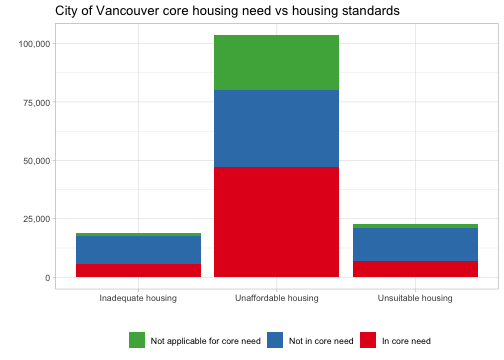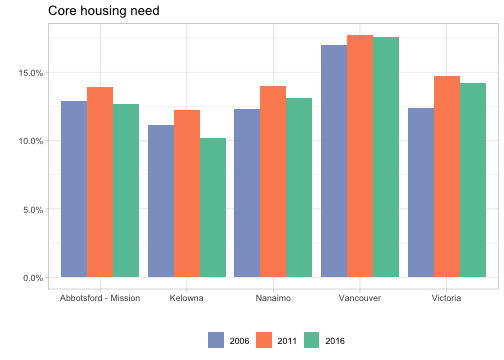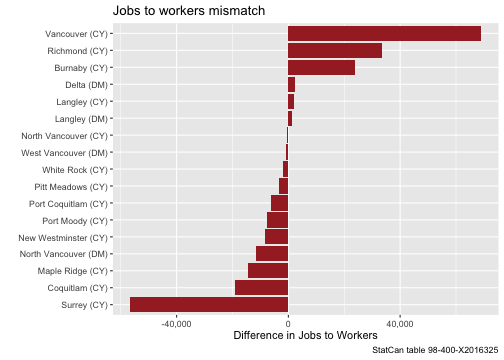class: center, middle, inverse, title-slide # Simple Metrics for Deciding If You Have Enough Housing ## Housing Central ### Jens von Bergmann & Nathan Lauster ### 2019-11-18 --- <style> .large { font-size: 130%;} .small { font-size: 70%;} .tiny{font-size: 40%;} .width-40 {width: 40%;} .width-30 {width: 30%;} .less-top-margin {margin-top:-120px;} </style> ## Do we have enough housing? Answers depend upon “**for what?**” But they also depend upon metrics used. * Different metrics answer different questions. * Different metrics assume different mechanisms. * Different metrics provide different "voting" representation. * Different metrics have different legal incorporation. Scale of Metric always Matters! (Simpson's Paradox) Some Common Elements: <span style="color:green;">Dwellings, Money, People, Land</span> ??? **Nathan** For example, if the goal is to "preserve livability or 'character'" one arrives at different set of metrics than when goal is "addressing housing need". --- ## Operationalizing Elements **Dwellings** can be measured * as discrete dwelling units (see also housekeeping, sleeping, etc.) * as floorspace (livable square meters) * as bedrooms * in categories (by tenure, structure, etc.) -- **People** can be measured * into categories by age, sex, ability, residence, etc. -- **Money** can be measured * by price, rent, ROI, income, wealth, credit, taxes, etc. -- **Land** can be be measured * by size (square footage, sq km) & Location ??? **Nathan** Another distinction that has been made by by various groups is taxpayers vs non-taxpayers People that already live in a place vs people that want to move to the place --- ## Do we have enough housing? | Simple Metrics | For what? | Mechanism| Representation | Legal Incorporation | | ------- | ------------- | ----------- | | Money / Dwelling | Promote affordability / make $ | Market allocation | Unequal, Includes potential movers | Limited (rent control, targets, etc.) | | Person / Dwelling | Avoid residential crowding | Rationing allocation | Mostly Equal, Excludes potential movers | Sharing Rules (occupancy codes) | | Dwelling / Land | Promote / Avoid Urbanism | Rationing allocation| Mostly Absent | Sharing Rules (zoning) | ??? **Nathan** --- ## Money per Dwelling (Price/Rent) .pull-left[ **For What?** Enough to Preserve Affordability? (or exclusivity / make $) **Mechanism**: Market Price as meeting point of Supply (Enough) & Demand… Reflects vast majority of actual production & distribution of housing **Representation**: Unequal (weighed by wealth/income) But incorporates potential movers & uncounted! **Legal Incorporation**: Limited (Rent Control, Building Targets, School Tax triggers, etc.) ] .pull-right.less-top-margin[  .tiny[(via http://housing-analysis.blogspot.com)]  ] ??? **Jens** --- ## Persons per Dwelling (Crowding) .pull-left[ **For What?** Enough to Avoid Residential Crowding? **Mechanism**: Rationing (Reflects non-market housing) **Representation**: Mostly equal (though see need-based distinctions) Almost never incorporates potential movers & uncounted! **Legal Incorporation**: Sharing Rules (Max Occupancy Codes, NOS, Fire Bylaws) ] .pull-right.less-top-margin[   ] ??? **Nathan** --- ## Dwellings per Land (Density) .pull-left[ **For What?** Enough to Promote / Prevent Urbanism? Enough to support workers living close to jobs? **Mechanism**: Rationing (though see Density Bonusing) **Representation**: People mostly don't get to vote through this metric (but often fought over) **Legal Incorporation**: Sharing Rules (Zoning Bylaws, etc.) ] .pull-right.less-top-margin.width-40[  ] ??? **Nathan** --- ## Enough Housing to Promote Affordability? <table> <thead> <tr><th>Simple Metrics</th><th>For what?</th><th>Mechanism</th><th>Representation</th><th>Legal Incorporation</th></tr> </thead> <tr> </tr> <tbody> <tr style="background: green;"> <td>Money / Dwelling</td> <td>Promote affordability / make $</td> <td>Market allocation</td> <td>Unequal, Includes potential movers</td> <td>Limited (rent control, targets, etc.)</td> </tr> <tr> <td>Person / Dwelling</td> <td>Avoid residential crowding</td> <td>Rationing allocation</td> <td>Mostly Equal, Excludes potential movers</td> <td>Sharing Rules (occupancy codes)</td> </tr> <tr> <td>Dwelling / Land</td> <td>Promote / Avoid Urbanism</td> <td>Rationing allocation</td> <td>Mostly Absent</td> <td>Sharing Rules (zoning)</td> </tr> </tbody> </table> ??? **Nathan** --- ## Enough Housing to Promote Affordability? <table> <thead> <tr><th>Simple Metrics</th><th>For what?</th><th>Mechanism</th><th>Representation</th><th>Legal Incorporation</th></tr> </thead> <tr> </tr> <tbody> <tr> <td>Money / Dwelling</td> <td>Promote affordability / make $</td> <td>Market allocation</td> <td>Unequal, Includes potential movers</td> <td>Limited (rent control, targets, etc.)</td> </tr> <tr style="background: red;"> <td>Person / Dwelling</td> <td>Avoid residential crowding</td> <td>Rationing allocation</td> <td>Mostly Equal, Excludes potential movers</td> <td>Sharing Rules (occupancy codes)</td> </tr> <tr> <td>Dwelling / Land</td> <td>Promote / Avoid Urbanism</td> <td>Rationing allocation</td> <td>Mostly Absent</td> <td>Sharing Rules (zoning)</td> </tr> </tbody> </table> ??? **Nathan** --- ## Enough Housing to Promote Affordability? <table> <thead> <tr><th>Simple Metrics</th><th>For what?</th><th>Mechanism</th><th>Representation</th><th>Legal Incorporation</th></tr> </thead> <tr> </tr> <tbody> <tr> <td>Money / Dwelling</td> <td>Promote affordability / make $</td> <td>Market allocation</td> <td>Unequal, Includes potential movers</td> <td style="background: green;">Limited (rent control, targets, etc.)</td> </tr> <tr> <td>Person / Dwelling</td> <td>Avoid residential crowding</td> <td>Rationing allocation</td> <td>Mostly Equal, Excludes potential movers</td> <td style="background: green;">Sharing Rules (occupancy codes)</td> </tr> <tr> <td>Dwelling / Land</td> <td>Promote / Avoid Urbanism</td> <td>Rationing allocation</td> <td>Mostly Absent</td> <td style="background: green;">Sharing Rules (zoning)</td> </tr> </tbody> </table> ??? **Nathan** --- ## Enough Housing to Meet Need? Requires asking & answering: * what is need? * how are we allocating to meet need? * who are we enabling to "vote" themselves in need? * what legal rules can incorporate need? ??? **Nathan** Market filtering may not work fast, or at all, and rationing rules remaing highly subjective --- ## Unmatched Persons .pull-left[ Homeless Counts & Wait Lists Need as not having an appropriate dwelling * allocation: market (filtering) vs. rationing * enabled to vote: - those counted or listed only - categorized by need * legal rules: - right to housing - prevention / pre-emption of vagrancy laws ] .pull-right[  ] ??? **Nathan** Highest priority on the Needs scale. Strategies: * managing homelessness through shelter space * understanding pathways and dweling with causes of homelessness. --- ## Unmatched Dwellings .pull-left[ #### Empty Homes - A solution to need? Can signal a variety of things, * market at work allocating & pricing (rental vacancies, for sale, etc.) * market failing to meet need (vacation homes, speculative empty, etc.) * allocation: market to rationing * potentially in need: how would be rationed? * legal rules: - expropriation - empty-homes taxes ] .pull-right.less-top-margin.width-30[   ] ??? **JENS** We all have heard about the 25k empty homes in CoV or 67k empty homes in Metro Vancouver. Only about 1 in 9 show up as taxed (under EHT or SVT), most only vacant for short time or exempt. It's important to correctly interpret high-level "empty homes" numbers in order to correctly gauge the magnitude of unproductive vacancies and tailor policy solutions. --- ## Core Housing Need .pull-left[ A complicated metric Incorporating: * Money / Dwelling & Money / Person (set at max % income on rent) * Person / Dwelling (NOS) * Repair (not discussed here) * Dwelling / Land (only tangential) * excludes subgroups like full-time students, on-reserve, & on-farm * availability of local alternatives (imperfect) ] .pull-right.less-top-margin.width-40[ <!-- --> <!-- --> ] ??? **Jens** Core housing need is a more complex metric that incorporates a variety of simple metrics & different housing standards, as well as location and different needs of sub-segments. Some standards (i.e. NOS occupancy) are increasingly recognized as problematic, and some populations are missed, but the Core Housing Need is widely recognized as a good-faith effort to at least try and come up with a measurement addressing what kind of housing Canadians might have a right to... * For example, full-time (non-family) students largely fail the affordability standard due to lack of income, but are not considered in core housing need. * Similarly, people living in an SFH and failing the affordability standard that are still able to rent an *adequate* dwelling in the same municipality are not considered in core housing need. Finer metrics help better target those in need. --- ## Unmatched workers .pull-left[ People relocate to different metropolitan areas for jobs (and amenities). Comparing the number of jobs to the number of workers can give an indication if we have enough housing. * Another way of thinking about regional need * Mismatch can occur on a regional level when there isn't enough housing for workers to fill vacant jobs. * Mismatch can occur within the region when housing isn't built near jobs, forcing people into longer commutes. ] .pull-right.less-top-margin.width-40[   ] ??? **Jens** The fundamental economic role of cities is facilitate matching people with jobs. When we don't provide enough housing for the required workforce, or provide housing only far away from jobs, the city fails in this fundamental role. This failure leads to overall increases in prices and rents, and increased price gradients within the city, due to scarcity and income sorting. --- ## What happens when we mis-diagnose? .pull-left[ #### We have enough housing, but think there is not enough If we encourage more housing to get built, prices will fall. Less desireable homes, or homes in less desirable locations will stay vacant. ] .pull-right[ #### We don't have enough housing, but think there is enough If we restrict housing growth in a housing shortage, prices will escalate and income filtering will set it, pushing lower income people out. Economic growth gets impacted as companies can't find enough workers and workers can't move to jobs. ] --- ## Do we have enough metrics? | Simple Metrics | For what? | Mechanism| Representation | Legal Incorporation | | ------- | ------------- | ----------- | | Money / Dwelling | Promote affordability / make $ | Market allocation | Unequal, Includes potential movers | Limited (rent control, targets, etc.) | | Person / Dwelling | Avoid residential crowding | Rationing allocation | Mostly Equal, Excludes potential movers | Sharing Rules (occupancy codes) | | Dwelling / Land | Promote / Avoid Urbanism | Rationing allocation| Mostly Absent | Sharing Rules (zoning) | Important to think through metrics & keep building new ones. Housing is complex, no one metric will capture everything. --- class: center inverse ## Simple Metrics for Deciding If You Have Enough Housing #### Nathan Lauster & Jens von Bergmann